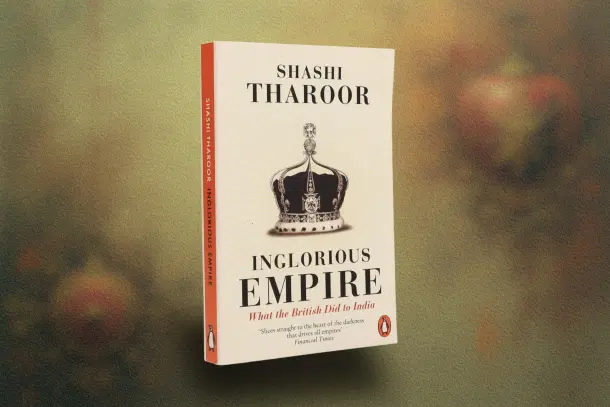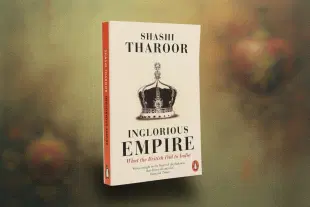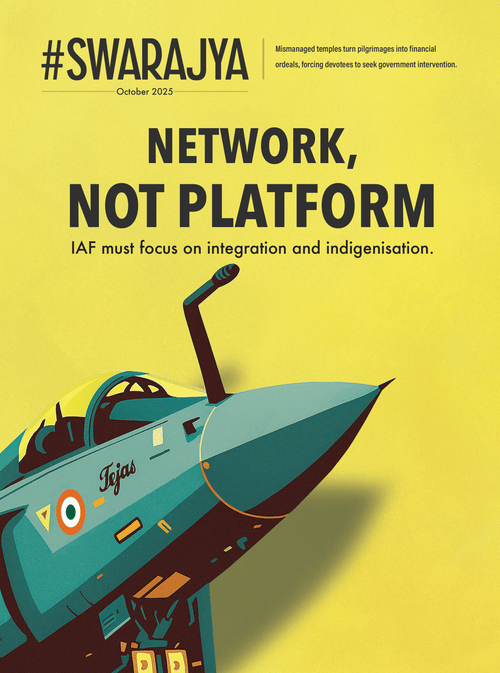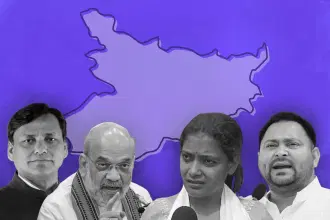Books
Bounty Built On Bones: An Audit Of The British Empire In India
Krrishna Rout
Nov 02, 2025, 08:00 AM | Updated Nov 01, 2025, 12:45 PM IST
Save & read from anywhere!
Bookmark stories for easy access on any device or the Swarajya app.


Inglorious Empire: What the British Did to India. Shashi Tharoor. Pages: 294. Price: Rs 2371.
In the beginning, there were two nations. One was a vast, mighty and magnificent empire, brilliantly organised and culturally unified, which dominated a massive swath of the earth. The other was an undeveloped, semi-feudal realm, riven by religious factionalism and barely able to feed its illiterate, diseased and stinking masses. The first nation was India. The second was England.Alex von Tunzelmann, Indian Summer (2007)
Shashi Tharoor’s Inglorious Empire: What the British Did to India is an expansion of his speech at the Oxford Union on the proposition, ‘Britain Owes Reparations to Her Former Colonies’. Shashi Tharoor’s book attains credibility from the fact that he has had a stellar career of serving at the United Nations for twenty-nine years, authoring more than a dozen books, winning numerous literary awards, and currently working in the domain of Indian politics as a Member of Parliament (MP) from the Indian National Congress. His book is a reflection of his grasp of history and his knowledge of pragmatically dealing with contentious political questions.
The book lies well within the genre of Indian history, covering extensively the coming of colonialism, the postcolonial, as well as the post-colonial experience. It does not shy away from holding the Britons accountable for the atrocities and the devastation inflicted upon the subcontinent. It reflects Tharoor's prowess at argumentation, which is well researched and backed by relevant data. His writing style is not restricted only to direct factual argumentation. He makes use of metaphors and lighter notes to make the book reader-friendly for people across diverse fields, rather than restricting it only to academics pursuing history or humanities. He has a multi-faceted approach to counter the arguments and is not just restricted to one aspect, unlike the pro-British opposition.
Tharoor, with regard to his speech, writes in favour of the motion at the Oxford Union that the right form of atonement would be to teach unromanticised colonial history. They must understand their historical responsibility so that the ongoing anti-Indian sentiments and racial discrimination come to an end. Indians, in the twenty-first century, are endorsing and practising atithi devo bhava (The Guest is God) while their own brothers and sisters, as immigrants or as travellers, are getting looked down upon due to their race. Xenophobia and the superiority complex have persisted due to unawareness and a lack of proper education. True atonement would be the day when one is not defined by their skin colour.
The preface of a book speaks a lot about the author, and so it did. Tharoor's book beckons acceptability to both Bangladeshis and Pakistanis who deem India’s past as theirs too, for once the entire geographical, political and demographic entity of present-day Pakistan, Bangladesh, and India was all together. Tharoor was not dismissive of these states, which are often looked at with suspicion. He found brotherhood in the trifecta’s common colonial past, which weaves them together as sufferers at the hands of the marauders.
The author has also incorporated the opposition’s argumentation on justifying the British rule and denying reparations. It reflects Tharoor's willingness and ability to counter them. He does not shy away from the questions that might fault Congress’s misgovernance from the initial years. He remains true to the reader by mentioning both sides of the argument, from the Britishers’ and the Indians’ perspectives, and then leaves it to their rational understanding to decipher and choose a side.
From Trade to Torment
The book brings forth India's beauty and prosperity not through the eyes of an Indian, which may be biased for their motherland, but from those of the Britishers. India was all-encompassing, from jewels to metals, merchants to manufacturers. Upon reading the book, one realises that India truly was the ‘Jewel in the Crown’ (quite literally, until they annexed the Koh-i-Noor). The sone ki chidiya (golden bird) was starved to death with deindustrialisation, extinction of Indian textiles, rural poverty, hypocrisy in trade and tariffs, where exports became costlier and imports cheaper, taxation began at fifty per cent, and where everything and everybody was on sale. Britain’s development was based upon the underdevelopment of its colonies. It thrived on the dependency of the colonised. They drained India physically, mentally, and economically to the extent that it felt as if “Indians literally paid for their oppression”. (Tharoor, 2017)
With regard to the subjugation and enslavement of the Indians, he talks about how the British stole our golden empire from right under our noses. Indeed, the sycophancy and treachery of some Indians came into play, but within fifteen years of arrival in India as traders, they had already spread their tentacles of control all across. They hid their malice under the garb of serving the Mughals and other princes as facilitators. Later, they turned out to be the biggest backstabbers, stealing their thrones. After reading the book, it is safe to say that India was the major contributor in adding the “Great” to Britain, whether it was through the supply of raw materials, Indian soldiers fighting in wars on behalf of Britain, rich metals, gold, diamonds being pillaged, or the fact that India’s contribution in world economy dipped from twenty-seven per cent to barely three to five per cent whilst rendering its services to the colonisers.
Indeed, the Indians suffered the tyranny of the Britishers. However, it was not always this way. What is interesting to note is that the initial years of invasion were characterised by ‘chutnification’ and ‘white mughals’ as the spirit of racism was not as appalling, and the Britons were ready to adapt and cooperate. Whether it was through diet, clothes-wise through khakis, marriages with Indian women, or even incorporating Indian words into the English language, such as loot.
Virtues of the Book
The book is descriptive in nature. It makes one aware of the gruesome manner of conduct, whether it was breaking the fingers of weavers to prevent them from making high-quality textiles or kicking in the stomach of servants with already enlarged spleens, which led to their deaths. Not to mention, the law and order that the British took pride in was extremely colour-conscious in declaring punishments. The book also upholds the values of gender sensitivity by addressing the dismissal of homosexuality and women under the chapter: Democracy, the Press, the Parliamentary System and the Rule of Law. The readers may come across multiple new revelations that have now become so ingrained and normalised, like prostitution, which was a term given by the British to devadasis (hereditary female dancers in Hindu temples) and baijis (highly skilled female entertainers), making them seem lowly.
Chapter four: Divide Et Impera (divide and rule), though deep and lengthy, is well explained. A sensitive topic like religion is handled well without hurting the sentiments of any one community. Under this chapter, one also gets to witness the transition of Muhammad Ali Jinnah from being the "cause of hindu-muslim unity" as coined by Sarojini Naidu during the Lucknow Pact to advocating for the two-nation theory. In addition, the interstitial notes are impressive and informative, making the reader curious and keeping them hooked.
It is not very complex or a heavy read, rather suitable for students from eighth grade onwards, and especially for those in senior secondary pursuing humanities as their stream, as the book explores aspects that are quite fundamental to their syllabus. In addition, this book is recommended as a good opener to anyone who wishes to learn more about the colonial history of India, with an unbiased point of view. The book draws a skeletal structure of history, incorporating almost every important aspect through its chapters and sub-sections. The book, in its writing style, can more often be seen as tilting towards a response-type format than a generic history run. However, it is not as radical and subaltern as one would expect a book written by an Indian against the “Inglorious Empire” to be, rather nuanced and at times avoids extreme stances, which makes one assume that so has been done to ensure that it does not alienate the foreign audience.
Between Conviction and Contradiction
What is also a noticeable aspect of the book is that the author mentions quotations of the Britishers from the time of colonisation, which is a direct reflection of their insatiable greed and abundance that they wished to exact from India. The sayings by the colonisers add life to the text, as well as substantiate Tharoor’s pro-India argument. We get to understand the procedure of colonisation not just from the viewpoint of the colonised but also from that of colonisers who derived great pleasure in doing the same. However, the only downside to it is that the direct quotes are so frequently dotted that they break the flow of the reader and act as a hindrance.
One also comes across slight redundancy in the initial chapter, which constantly refers to paragraphs related to the depletion and exhaustion of India’s resources. The same point is reiterated through quotations by the Britishers, acknowledging the drainage. Such repetition causes the reader to lose interest.
Here, the book mentions Gandhi and Nehru, with the nationalist movement in purview. However, not even a line or two was dedicated to those who martyred like Bhagat Singh or Chandra Shekhar Azad, which is unexpected since the author acknowledges that even Gandhian ideas of peace and non-violence have their own limitations. Hence, mention of the freedom fighters who believed in a more radical response to colonisation would have been beneficial than sticking to the mainstream well-known Gandhians.
However, what is quite a revelation is getting to know about the author’s unwavering support for the Presidential form of government, which is evidently known for reduced accountability. In addition, his views on amending the “draconian law of sedition” are also debatable. He has not made it quite clear as to what qualifies to be credible enough to incite violence. His definition of sedition is not well-defined and is very loosely explained. He states, “Mere words or signs criticising the measures or administrative actions of the government will not constitute sedition.” So, is the Khalistani flag being hoisted with rallies demanding secession in the subcontinent justified?
What is also concerning is the release of the book with two separate titles for India and abroad. The original Indian edition, published in 2016, was titled An Era of Darkness: The British Empire in India, and the United Kingdom edition, released in 2017, was given the title Inglorious Empire: What the British Did to India. Even though the content remains the same, the difference in titles leaves quite a mark. Indeed, so was done to target the separate markets, which, as one may assume, reflects the author’s intention to prevent the title from sounding too insolent to the readers abroad. Such a step goes against what was proposed in the book, that is, reviving the reader’s pride in pre-colonial India. The author, hence, should not have submitted to publishing his book with a separate title to attain the Britons’ approval and greater market value.
Therefore, one can say that though the book has several high points, certain claims that reflect the author’s stance are debatable, which should have been explained better to keep the clash of intent between the author and reader at bay.
Final Take
Shashi Tharoor says, “One cannot, as I have written elsewhere, take revenge upon history; history is its own revenge.” The arc of history bends towards truth, even if slowly. Revenge is not always personal; it can be systemic, cultural, or historical. The Britishers' mistakes are incorrigible, and they can’t run from them. One can find a resemblance of thought in the form of karma (deed) and dharma (duty) from Indian philosophy. You shall reap what you sow, and the wheel of karma will take a full circle to hold all those accountable who have done the colonies wrong.
The last chapter of the book serves as a fitting reply to the questions raised by drawing the contemporary relevance of colonialism and how the Britishers can make amends. Elements of colonialism are so entrenched that it is hard to leave them behind, be it the wars with Pakistan or India’s parliamentary democracy, the colonial infrastructure, like Connaught Place, to roads still under their names, like the Chelmsford Road, the importance of English as a language, or the love for cricket. Tharoor also made it a point to emphasise that any inefficiencies on behalf of the governments since Independence have never been blamed on the colonial encounter, worth two hundred years. To conclude, the takeaway is that it is essential to know one’s past to understand the present and shape the future, as he accurately mentions, "The best crystal ball is the rear view mirror".





